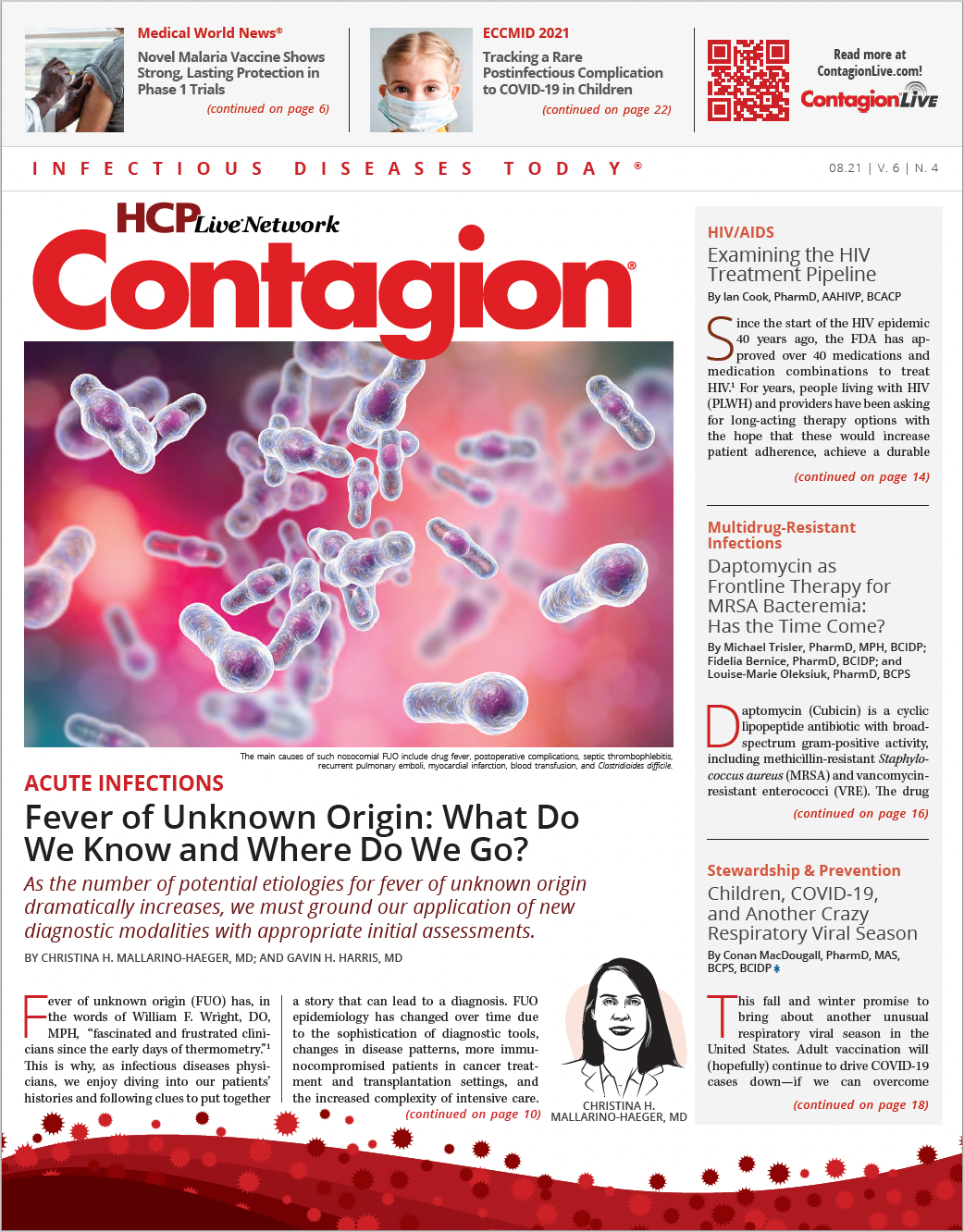Children, COVID-19, and Another Crazy Respiratory Viral Season
Kevin J. Downes, MD, and Contagion® Section Editor Conan MacDougall, PharmD, MAS, BCPS, BCIDP, discuss these important topics as another season approaches.
Kevin J. Downes, MD

This fall and winter promise to bring about another unusual respiratory viral season in the United States. Adult vaccination will (hopefully) continue to drive COVID-19 cases down—if we can overcome vaccine hesitancy. Vaccinated people will be triumphantly ditching their masks, except immunosuppressed patients who may not mount as robust of an antibody response. Children will likely be returning to in-person school under varying masking and distancing conditions and before the availability of vaccination for younger children. Assuming a COVID-19 vaccine is approved for younger children, parents will have to make risk-benefit decisions about vaccinations for those children during a time when the levels of circulating virus may be low. Additionally, other respiratory viruses such as influenza that were near absent in the 2020-2021 season will return, whether with vengeance or a whimper. Conan MacDougall, PharmD, MAS, BCPS, BCIDP, Contagion®’s section editor for Antimicrobial Stewardship and Infection Prevention, discusses these and other questions with Kevin J. Downes, MD, an attending physician in the Division of Infectious Diseases at Children’s Hospital of Philadelphia in Pennsylvania.
Conan MacDougall (CM): You help take care of sick and vulnerable children in the hospital, some of whom have had COVID-19 or are at risk of severe COVID-19. What do you wish people who may be hesitant to get vaccinated, or who downplay the disease, knew about your experience?
Kevin J. Downes (KD): Since the pandemic began, death has been the focal point of discussions about COVID-19. Understandably, early vaccination efforts were focused on those who were most vulnerable: older adults, immunocompromised individuals, and health care workers. In turn, people have viewed their own vaccine decisions in light of their personal risk of death from COVID-19. While reducing one’s risk of death is certainly a goal of vaccination, it’s not the only reason to get vaccinated. COVID-19 vaccines protect you and those around you. So it frustrates me when I hear people say they don’t want to get vaccinated because they feel that their risk of dying from [the disease] is low. While that may or may not be true, that argument ignores the risk that being unvaccinated poses to others who can’t get vaccinated, such as children, or who may not be fully protected with vaccines, such as immunocompromised individuals.
Along these lines, there has been an argument against vaccinating children because they are at low risk for severe disease. But kids can get sick and die from COVID-19. They can be hospitalized with it, get complications from it, and develop long-term symptoms following it. While it’s true that kids are at a lower risk of dying from COVID-19 than older adults, vaccination will keep kids safe too. For now, while young children remain ineligible for vaccination, the best way for us to protect them is to get everyone around them vaccinated.
CM: We’ve seen the rapid study and deployment of a variety of experimental therapeutics for COVID-19 over the last year, some successful and many not. Most of those studies were performed in adults. What were the challenges in adapting those data for use in pediatrics?
KD: What’s been most consistently challenging [in terms of] COVID-19 therapeutics has been to figure out the risk-benefit for children. This is primarily because age has been such an important factor influencing COVID-19 severity and outcomes. As a result, it’s been really hard to extrapolate how the treatment effects [shown in results] from adult studies apply to kids. For example, many COVID-19 therapeutics have focused on preventing death in hospitalized patients with severe disease. But the risk of dying from COVID-19 is higher for a hospitalized adult than it is for a child. So even if [the results of] a study find that there’s a significant mortality benefit in hospitalized adults, that doesn’t mean the same benefit would be present in children. We’ve really had to look carefully at the data, at the population studied, and the setting in which these therapeutics were used to try to estimate the risk-benefit in children. Even now, after a year, we still don’t have strong pediatric-specific data for most COVID-19 therapeutics.
Another challenge has been identifying which children are at highest risk for severe [illness]. Drugs that have been studied for the prevention of progression from mild to severe COVID-19, such as monoclonal antibodies, have largely focused on patients at high risk for poor outcomes from COVID-19. However, since fewer children develop severe COVID-19, it has not been readily apparent which pediatric populations these are. We have relied largely on our experience with other respiratory viruses to know who is most vulnerable.
CM: Looking ahead to the fall and to influenza vaccination season, have the COVID-19 vaccination experiences taught us lessons we could apply toward other vaccine campaigns, like flu, or are the COVID-19 vaccinations just too different?
KD: One of the rallying cries for COVID-19 vaccination has been to bring about a return to normalcy. I don’t think that theme will promote uptake of the influenza vaccination this fall. Flu has been a part of people’s normal lives for a long time and many people have already decided if being protected against flu is something that’s important to them. However, I do think there will be an opportunity to build on the messaging surrounding staying healthy. If COVID-19 remains circulating in communities this fall and winter, which is likely, it will continue to be important to identify and isolate cases quickly. That means testing people who have febrile or respiratory illnesses for COVID-19 to know what’s COVID-19 vs flu or another virus. One way to stay healthy this winter will be for people to get their flu shots. So even if people are not worried enough about the flu specifically, we may be able to build on the idea that it will be important to be protected against all viruses.
CM: At my hospital we are taking advantage of hospital admission to vaccinate many adult inpatients against COVID-19, regardless of their reason for admission, as we do with influenza. As vaccines are approved for a greater spectrum of pediatrics, do you foresee a similar approach for children admitted to your hospital?
KD: This is the ‘vaccinate ‘em while you got ‘em’ strategy, which is a good way to vaccinate as many people as possible. This can be an effective method to combat some of the access issues that have prevented adults from getting vaccinated against COVID-19, and [it helps them] avoid the need for a separate…visit for a COVID-19 vaccination. But I am not sure how this will play out in pediatrics. Certainly, there could be an appeal for some families as it’s 1 less health care visit. However, the COVID-19 vaccines that are currently approved for children 12 and older are 2-dose series [ones] and I don’t know when single-dose vaccines will be available for them. As a result, if a pediatric hospital were to implement this approach, it would also be important for that hospital to ensure that the child will have access to a second dose to complete the series. Additionally, …a number of communities have been able to successfully administer COVID-19 vaccination programs in older children through schools. This is probably a better and more efficient approach to ensure access to COVID-19 vaccines for children than through the hospital setting.
CM: We basically went without a flu season last year and the incidence of other respiratory viral infections was significantly decreased or shifted in seasonality. Did we learn anything from this experience that might alter practice once those viruses come back?
KD: Masks and social distancing work. This has been reiterated time and time again during this pandemic. Despite the naysayers, the epidemiology of non–COVID-19 respiratory viral infections this past year has clearly borne this out. As you mention, we saw essentially no influenza transmission last year––I believe the CDC reported just a single pediatric death from flu all of last season––which is a testimony to the effectiveness of the public health measures put in place. While this may not change how most people behave, I would not be surprised to see masks being worn more routinely when people cannot maintain social distancing, such as on planes, on public transportation, etc. Hopefully we can all embrace this. That’s not to say everyone should be wearing masks. But if a person feels more comfortable wearing one because they know it keeps them safer, then that should be accepted and even encouraged. Certainly, for immunocompromised individuals, who are at higher risk for severe infections not only from SARS-CoV-2 but other respiratory viruses, I believe that the effectiveness of masks and distancing will have longer lasting implications on general infection prevention guidance…. And we hopefully will see more routine mask wearing in health care settings, especially during winter months.
CM:A lot of attention has been given recently to transplant patients, who appear to have decreased antibody responses to COVID-19 vaccines. Should transplant recipients or other immunocompromised patients routinely get extra doses of COVID-19 vaccines? Should they get a booster dose if their COVID-19 antibodies are low after completing the vaccine series?
KD: No, based on current information I would not administer extra doses of COVID-19 vaccine to transplant patients. It is not entirely surprising that transplant recipients would have decreased production of antibodies to COVID-19 vaccines compared with the general population. We know this to be true for influenza and some other vaccines as well. But having low-binding antibodies doesn’t necessarily mean that someone isn’t protected against COVID-19, particularly severe COVID-19. Cellular responses also contribute to immunity, and some transplant recipients may mount effective cellular responses without producing high antibodies. Furthermore, neutralizing antibodies, which are a better marker of protection than binding antibodies, are not measured by commercial antibody tests. While COVID-19 vaccines may be less immunogenic in transplant recipients, these data don’t tell us the extent to which the vaccines are clinically effective in this population. Until we know that, and we have tests that are true correlates of protection, I don’t think we should be recommending extra doses of vaccines, early boosters, or the routine performance of serologic tests. Instead we should be encouraging transplant recipients to get their vaccines and remain vigilant in their infection prevention practices. With continued research, we will know how effective these vaccines are against mild, moderate, and severe COVID-19 in the transplant population, which can inform recommendations about COVID-19 vaccine schedules and booster dosing.

2 Commerce Drive
Cranbury, NJ 08512
All rights reserved.
